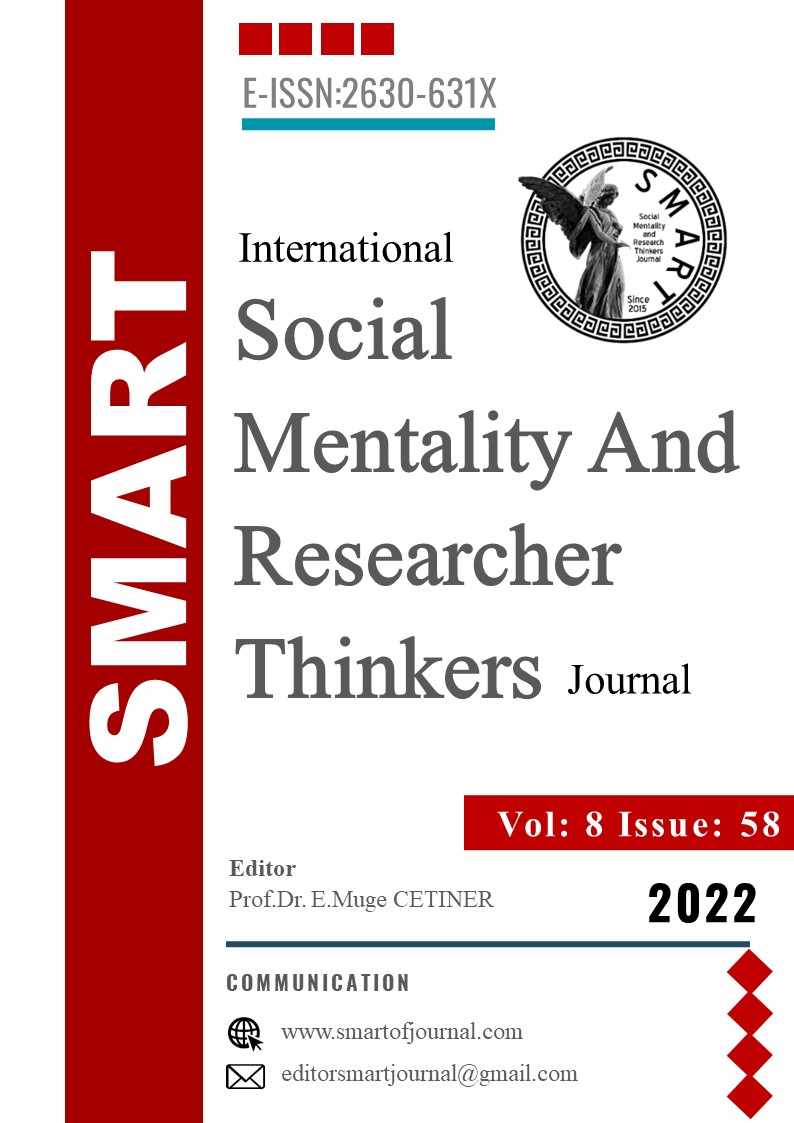Author :
Abstract
Kırkyama; giysi, aksesuar ya da ev tekstili ürünleri yapımı amacıyla atık veya atık olmayan kumaş parçalarını çeşitli tekniklerle birleştirme yöntemidir. Dünya’da çok geniş bir coğrafyada uygulanmış olan kırkyama, 5000 yıllık bir geçmişe sahiptir. Günümüze kadar yaşamaya devam etmiş olan dikiş tekniğinin çok yaygın olarak kullanılması ve köklerinin çok eskiye dayanmasıyla birçok sanatçıya ilham kaynaklığı etmiştir. Tekstil sanatlarında da kırkyama tekniği sanatçılar tarafından uygulanmıştır. Japon kırkyama sanatçısı Noriko Endo, kırkyamada sürdürülebilir tekstil anlayışı ile yeni bir teknik geliştirmiştir. Bu çalışmada kırkyama sanatçısı Noriko Endo’nun geliştirmiş olduğu tekniğin ve tekstil sanatı çalışmalarının incelemesi yapılmıştır.
Araştırmada sonuç olarak geleneksel atık değerlendirme yöntemi olan kırkyama tekniğinin sürdürülebilir bir anlayışı geliştirmesinin yanında sanatsal bir anlatım aracı olduğu Noriko Endo örneği ile sunulmaktadır.
Keywords
Abstract
Patchwork; İt is a method of combining waste or non- waste fabric pieces with varios techniques for he purpose of making clothes, accessories or home textile products. Patchwork, which has been applied in a very wide geography in the world, has a history of 5000 years. It has been a source of inspiration for many artists, with the widespread use of the sewing technique, which has survived to this day, and its roots dating back to ancient times. It has also been applied by technical artists in textile arts. Japanese patchwork artist Noriko Endo has developed a new technique in patchwork with an understanding of sustainable textiles. In this study, the technique developed by the patchwork artist Noriko Endo and the textile art studies were examined.
As a result of the research, it is suggsted with the example of Noriko Endo that the patchwork technique, which is a traditinal waste evaluation method, develops a sustainable understanding as well as an artistic expression tool.
Keywords
- Arabalı Koşar, S. T. (2021). Geleneksel Kırkyamanın Çağdaş Tekstil Sanatındaki Uygulamaları Üzerine Bir
- Arabalı Koşar, S. T. (2021). Geleneksel Kırkyamanın Çağdaş Tekstil Sanatındaki Uygulamaları Üzerine Bir Örnek: Füsun Özpulat. International Journal of Troy Art and Design , 97-115.
- Brubaker Knapp, S. (2010, Aralaık 15). Book Review and Give-away: Confetti Naturescapes by Noriko Endo.02 2022, 10 tarihinde Blue Moon River: http://wwwbluemoonriver.blogspot.com/2010/12/book-review-and- give-away-confetti.html adresinden alındı
- Büyüksofuoğlu, F. (2019). Tekstil Sanatında Zanaatın Yeri. İstanbul: Marmara Üniversitesi. Endo, N. (2010). Confetti Naturescapes: Quilting Impressionist Landscape
- Geleneksel Meslekler Rehberi-Ansiklopedisi (Cilt 2). (2021). Ankara: T.C. Ticaret Bakanlığı.
- Gürcan Akbaş, K., & İmre, H. M. (2019). Lif Sanatının Tarihsel Süreç İçerisindekiİ Devinimi Ve DikişTeknikleri Kullanılarak Gerçekleştirilen Lif Sanatı Uygulamaları. Journal Of Interdisciplinary And Interculturel Art, 4 (7), 101-119.
- Holmes, C. (2015). Stitch Stories. United Kingdom: Batsford.
- Kılıç Karatay, S. (2019 ). Kırkyama Geleneği ve Kullanım Alanları. Journal of Arts.
- Ok, M. (2020). Bir esin Kaynağı Olarak Giyim Modasında Mozaik Tekniği. Motif Akademi Halkbilimi Dergisi . (32), 1509-1525.
- Olguner Ergene, P. (2011). 18.yy VE 19.yy Türk İşleme Motiflerinde Sembol Dili ve Sembolizm İçerikli Yeni Yorumlar. İstanbul: Mimar Sinan Güzel Sanatlar Üniversitesi.
- Osmanoğlu, E. (1994). Orta Asya'dan Amerika'ya Uzanan İlginç Bir El Sanatı: Kırk-Yama. Art Dekor Dergisi (16-17), 128.
- Önbaş, S., & Mutlu, S. (2018). Geleneksel Atık Değerledirme Kırkyama. İksad.Özpulat, F. (1994). Geleneksel Kültürümüzde Kırkpare. Tekstil ve Mühendis , 37-41.
- Roseo, M. R. (2019, Nisan 03). Interview with Noriko Endo. 02 10, 2022 tarihinde Artemorbida Textile Art Magazine: https://www.artemorbida.com/intervista-con-noriko-endo/?lang=en adresinden alındı
- Roseo, M. R. (tarih yok). Interwiew With Noriko Endo. 02 02, 2022 tarihinde Artemorbida-Textile ArtsSeilman, M. (2008). Noriko Endo. M. Sielman içinde, Masters: Art Quilts : Major Works by Leading Artists (s. 50-60). New York/London: Lark Books.
- Shaw, R. (2005). Art Quilts:A Celebretion 400 Stunning ContemporaryDesigns (s. 427). içinde New York: Lark Books.
- Sönmez, E. (2019). Günümüz Sanatında Kırkyama Tekniğinin Kullanımı ve Uygulamalar. Ankara: Gazi Üniversitesi.
- Uğurlu, S. S. (2018). Geleneksel Tekstl Teknikleriyle Yeni Sanatsal Çalışmalar. İstanbul: Fatih Sultan Mehmet Vakıf Üniversitesi.





